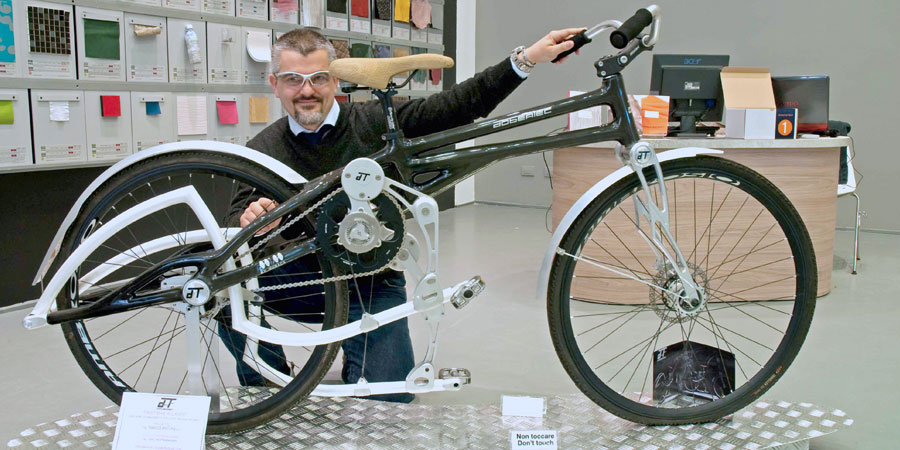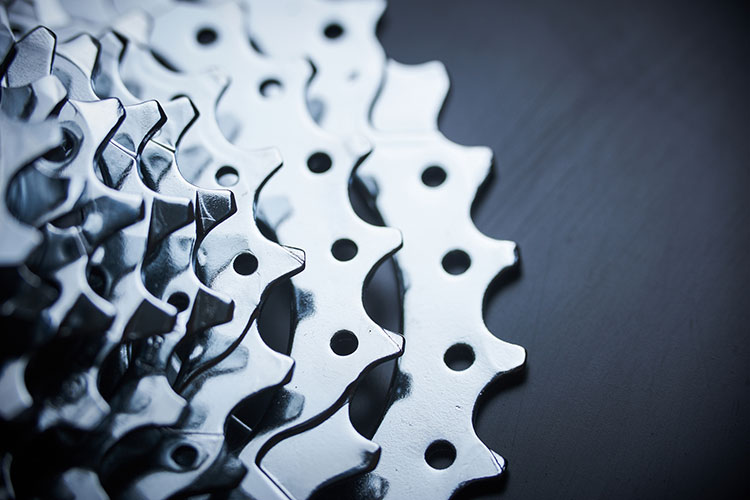The handbike of the future is designed with Creo
Usable both by people with or without disabilities or malformations of the lower limbs, the handbike is an instrument of cycling mobility on three wheels. Its structure is deceptively simple, composed as it is of a load bearing frame connected to which are the front fork and a rear axle which has innovative features. It is far from simple - a number of factors, mainly of a bio-mechanical nature, affect not only the physical well-being of the parathlete, but also the reliability of the vehicle. The experience of the engineer Marco Antonelli, who designed an innovative handbike thanks to the reliability, modeling simplicity and performance simulation offered by Creo, PTC's multi-award-winning computer aided design platform (CAD).
In recent years, thanks also to the efforts of popular sports figures, para-cycling has become one of the most popular and recognizable sports for the disabled covered by the media. The handbike athlete, often an ex-diver or motorcyclist, has typically suffered a spine injury leaving them paraplegic - if not tetraplegic - resulting in the loss of use of their legs or even the correct use of their hands.
Unlike the traditional bike, which uses the thrust of a rider's legs and feet, the handbike moves thanks to the strength in the rider's arms. In its standard conformation, the handbike is essentially composed of a frame, with a seat on which to either sit or lie down, to which the front wheels and two rear wheels are attached. The first, asides from being connected to the cranks via the chain, is integral with the steering, while the two rear wheels provide the bike with stability and balance.
Unique objects for unique athletes
The world of the handbike is now very technologically advanced which makes these cycling mobility instruments very similar to small Formula One in their innovative solutions and the materials used. However, despite the fact that paracyclism has gradually established itself, there has been a dearth of companies demonstrating a real interest in investing heavily in the research, if not for a privileged few. This is due to the fact that the numbers are still too low to support the budgets that are required making it nigh impossible to go down the road of a real business.
Each parathlete has different physical characteristics making it impossible to create a standard series which suits everyone. While able-bodied people have at least five different frame sizes, as well as different means and specific components for posture, in the case of parathletes, not only different body types and weights have to be considered, but also unique physiological characteristics based on the different type and degree of disability.
And this is where the two protagonists of this success story enter the scene: on the one side the engineer Marco Antonelli, university professor and industrial designer, on the other, Creo, innovative and multi-award-winning Computer Aided Design (CAD) platform by PTC.
A couple of years ago Marco Antonelli came across a project he probably never thought he'd apply himself to. While he was in a sports medicine center, following some professional activities in which he was involved (together with Paolo Venerito, deputy secretary of ANMIL), he was offered a proposal which he ended up accepting - a little due to the challenge and a little out of professional pride: to realize a handbike with completely innovative characteristics compared to those currently used.

"I have worked as a designer in the world of competitive motor racing for many years, maturing my experience with some of the most important designers in the sector, working together to develop a number of innovative solutions" said Marco Antonelli. I am, however, a bioengineer so it wasn't too much of a stretch for me to move from the development of an aid for an able-bodied person to specific solutions for people who are, unfortunately, hindered by physical problems. Combining passion and experience in product development gained over many years of experience, I began to get more and more interested in this project, which step by step evolved into a true complete functional model for parathletes.

Enter Creo
Creo, the computer aided design (CAD) platform by PTC and one of the most used platforms in the world, was used to design the handbike. This enabled us to obtain results which otherwise would have been impossible with other available software.
"The great advantage that Creo offers designers is not in its features, though these are impressive, but that it offers a harmonious environment, or rather is composed of a set of modules which not only make it functionally complete, but are perfectly integrated with one another from a data perspective. This is very important because, unlike other CAD systems available on the market, all the project information is immediately available which helps avoid, for example if you need to simulate modules, converting module formats or importing files which takes up a lot of time with an inevitable loss of information".
With Creo, the design process is perfectly integrated with the simulation which, thanks to the availability of Creo Simulation Live powered by ANSYS, a complete real-time simulation environment, is not only easy to develop but also has a significantly shorter time frame.
"The simulation is performed very quickly and, above all, with a use of computing resources and memory significantly lower than that required by other CAD systems, which I already tested during past projects, with a high calculation reliability," says Antonelli, who also focuses on another key feature: the retroactive scalability, which allows you to maintain full compatibility with files generated with previous versions of Creo without any loss of information.
Even the sketch management system, the starting point of the design, is also efficient and fast, and like simulation, requires only a limited commitment of resources. This makes it possible to work efficiently without necessarily having to invest in high performance hardware platforms.
Modeling and Simulation: Two Key Pillars
Reliability, modeling simplicity, and strong simulation capabilities. But that's not all "Creo's capabilities make it possible to make innovation an integral part of the design process," continues Antonelli, adding: "everything starts from the modeling, and the starting point before doing a structural simulation, is the model originated by the experience of the designer."
So, the design process sees a succession of results that are processed in cyclic loops step by step, with the subsequent input of changes where needed. Often, however, the changes made generate conflicts on secondary features, which in turn generates errors: this is where a design system must demonstrate the maximum result reliability.
"Creo is a very robust system that has timely and reliable diagnostic tools to resolve any conflicts and, as a result, correctly rebuild constraints. This is unlike other systems I've tested in the past, which often generated false positives and/or false negatives. This has never happened during the thousands of hours I've spent on Creo, not even when I started using it 15 years ago to develop products for the defense sector," Antonelli underlines.
A Granite Kernel for Stability and Interoperability
Creo's modeling kernel, Granite, is particularly effective, fast, and efficient, and unlike other kernels, is a single, dedicated solution, meaning it's not shared with third-party customers as is the case with other product kernels. "This is undoubtedly a big advantage, especially in terms of optimization and integration with other modules that Creo uses," says Antonelli. "As a user, I've really appreciated the outstanding integration work that PTC is doing with ANSYS, which has resulted in some fantastic simulation systems. In Creo, the feeling is that of working with complete transparency, always in the same working environment: everything is absolutely linear, without any hiccups when importing data or in the visibility of the other CAE, CAM or simulation modules."
An important point is that with Creo you can access all the project phases while always remaining in the same environment. “"Many vendors claim to have modules within their platforms, but more often than not these are third-party products that are, alas, poorly integrated," notes Antonelli. "personally, with Creo, I've never felt like I am accessing external tools, such as Creo Simulation Live, a tool that, as far as I'm concerned, is not only convenient and effective due to its perfect integration, but is also reliable and fast, sometimes able to return certain simulation results within just a few seconds."
Accurate meshes thanks to polynomial method and secure sharing via Augmented Reality
During the various stages of design, it is quite common for designers to have to waste many hours to mesh complex surfaces, as well as to make simplifications in order to be able to perform the simulation in reasonable time.
However, simplifying a shape can often lead to variations that can result in deviations of several percentage points from what will be the true final model at the end of the project. "I've never had this problem since I started using Creo", underlines Antonelli. "One of the strengths of Creo is the polynomial method: instead of linear approximation, it is possible to perform polynomial simulations up to the ninth degree and this, from a mathematical perspective, leads to a much higher degree of convergence, with a significant benefit in terms of mesh accuracy and also in processing times." This is an extremely important feature, especially in light of today's need to reduce time to market, which even the designers must adapt to.
Finally, when working with Creo, it's possible to publish the experience of an object in Augmented Reality by simply sending an email to the recipient, another invaluable benefit in terms of simplicity, safe sharing and time saved. "Through the email, the recipient can open the object and view it seamlessly with the augmented reality, as if they had Creo and the object themselves. There's no need to send sensitive data or JPGs or PDFs, which can also be used for reverse engineering," and the recipient just needs a tablet or smartphone to explore the model. In short, even the sharing of the objects is simple and immediate and, unlike as normally occurs when disseminating project information, it allows the protection of the designer's intellectual property rights.
An object of refined industrial design

The structure of the handbike designed by Antonelli is essentially composed of the same main components - frame and fork - that characterize the classic racing handbike. However, it encompasses a number of innovations that involved a series of not-so easy challenges.
Even if the project cannot be said to be concluded, the first prototype is currently being produced. The partner in this initiative is the Livornese company CRM Compositi which specializes in the creation of monolithic carbon structures and has the necessary skills and technical capabilities required in the field of composite materials.
"Making the frame lighter while maintaining its structural characteristics was very difficult," explains Antonelli. "CRM provided a unique system for the production of monolithic structures innervated entirely in carbon for this."
The integrated ribs make the frame structure much lighter and at the same time stronger, ensuring full reliability as they are monolithic. Originally developed for military applications, this is a technology that is now being used for the first time in a civilian environment with the design of this handbike.
Another very important phase of the project concerned the fork, which integrates the standard motion transmission components. The study of the transmission components was very complex right from the start, especially in relation to the possibilities of adjusting to the cycling system.
"The height adjustment of the handbike's central movement is normally entrusted to a pin that is fixed to the base of the steering head," explains Antonelli. "Naturally modifying even just the height of the central movement, changes the characteristic angles. This leads to a series of problems, topmost being the instability of the bike, which can have problems of tipping and uncontrollability. There can also be the incorrect postures by the parathlete, which can over time lead to inflammation, abnormal wear of the cartilages and loss of mobility of the upper limbs."
Conclusions
Today, Antonelli is experimenting with integrating Creo with Vuforia, PTC's augmented reality platform, to complete the project, capitalizing on combining the physical and digital worlds. This will allow the project to be deployed for testing with partners using AR technology, therefore also providing a highly engaging final experience that is as inclusive as possible of real-world details - all without distributing sensitive data that could be subject to intellectual property violations.
With sophisticated design objects such as Antonelli's handbike, no compromises are permitted. Creo has proven to be the perfect platform to combine the futuristic insights behind the design with the best use of available technologies, using a fraction of the resources required by other systems. The integration of Creo with Vuforia will further emphasize the benefits of the PTC platform, which engineer Antonelli uses not only for the handbike project, but also for other products with the same significant benefits.
